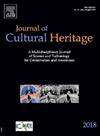Multianalytical study of neapolitan yellow tuff rotting: Archaeological park of herculaneum as a representative case of study
IF 3.5
2区 综合性期刊
0 ARCHAEOLOGY
引用次数: 0
Abstract
The eruption of Mount Vesuvius in 79 CE buried Herculaneum under volcanic material, preserving its structures and organic materials remarkably well. Today, this site is known as the Archaeological Park of Herculaneum. Unfortunately, exposure to environmental factors has led to the degradation of Neapolitan Yellow Tuff (NYT), a material commonly used in Roman buildings, through a process known as rotting. This study, conducted by the Herculaneum Archaeological Park (PAERCO) and the Herculaneum Conservation Project (HCP) in collaboration with the IBeA research group (Research and Innovation in Analytical Chemistry, University of the Basque Country UPV/EHU), aimed to understand the tuff rotting process. By combining in-situ non-destructive analyses with laboratory investigations, it was determined, that NYT rotting is caused by the capillary ascent of saline-rich ground humidity, leading to internal stress from salt crystallization, with sodium sulphate identified as a critical threat. Furthermore, the analyses indicated that salts chemically react with NYT's minerals, causing the selective loss of its cementing material (zeolites). The study of soil samples revealed that the risk of rotting varies across the park due to differences in salt concentration and composition. These insights will help PAERCO and HCP identify high-risk areas and implement preventive measures, including the use of portable XRF instruments for ongoing monitoring and preservation of the site's historic structures.
那不勒斯黄凝灰岩腐烂的多分析研究:以赫库兰尼姆考古公园为代表的研究案例
公元79年维苏威火山的喷发将赫库兰尼姆掩埋在火山物质之下,很好地保存了它的结构和有机物质。今天,这个地方被称为赫库兰尼姆考古公园。不幸的是,暴露于环境因素导致那不勒斯黄色凝灰岩(NYT)的降解,这种材料通常用于罗马建筑,通过一个被称为腐烂的过程。这项研究由赫库兰尼姆考古公园(PAERCO)和赫库兰尼姆保护项目(HCP)与IBeA研究小组(巴斯克地区UPV/EHU大学分析化学研究与创新)合作进行,旨在了解凝灰岩腐烂过程。通过将现场非破坏性分析与实验室调查相结合,确定NYT腐烂是由富含盐分的地面湿度的毛细管上升引起的,导致盐结晶产生内应力,硫酸钠被确定为严重威胁。此外,分析表明,盐与NYT的矿物发生化学反应,导致其胶结材料(沸石)的选择性损失。对土壤样本的研究表明,由于盐浓度和成分的不同,整个公园腐烂的风险也有所不同。这些见解将有助于PAERCO和HCP确定高风险区域并实施预防措施,包括使用便携式XRF仪器进行持续监测和保护现场的历史建筑。
本文章由计算机程序翻译,如有差异,请以英文原文为准。
求助全文
约1分钟内获得全文
求助全文
来源期刊

Journal of Cultural Heritage
综合性期刊-材料科学:综合
CiteScore
6.80
自引率
9.70%
发文量
166
审稿时长
52 days
期刊介绍:
The Journal of Cultural Heritage publishes original papers which comprise previously unpublished data and present innovative methods concerning all aspects of science and technology of cultural heritage as well as interpretation and theoretical issues related to preservation.
 求助内容:
求助内容: 应助结果提醒方式:
应助结果提醒方式:


